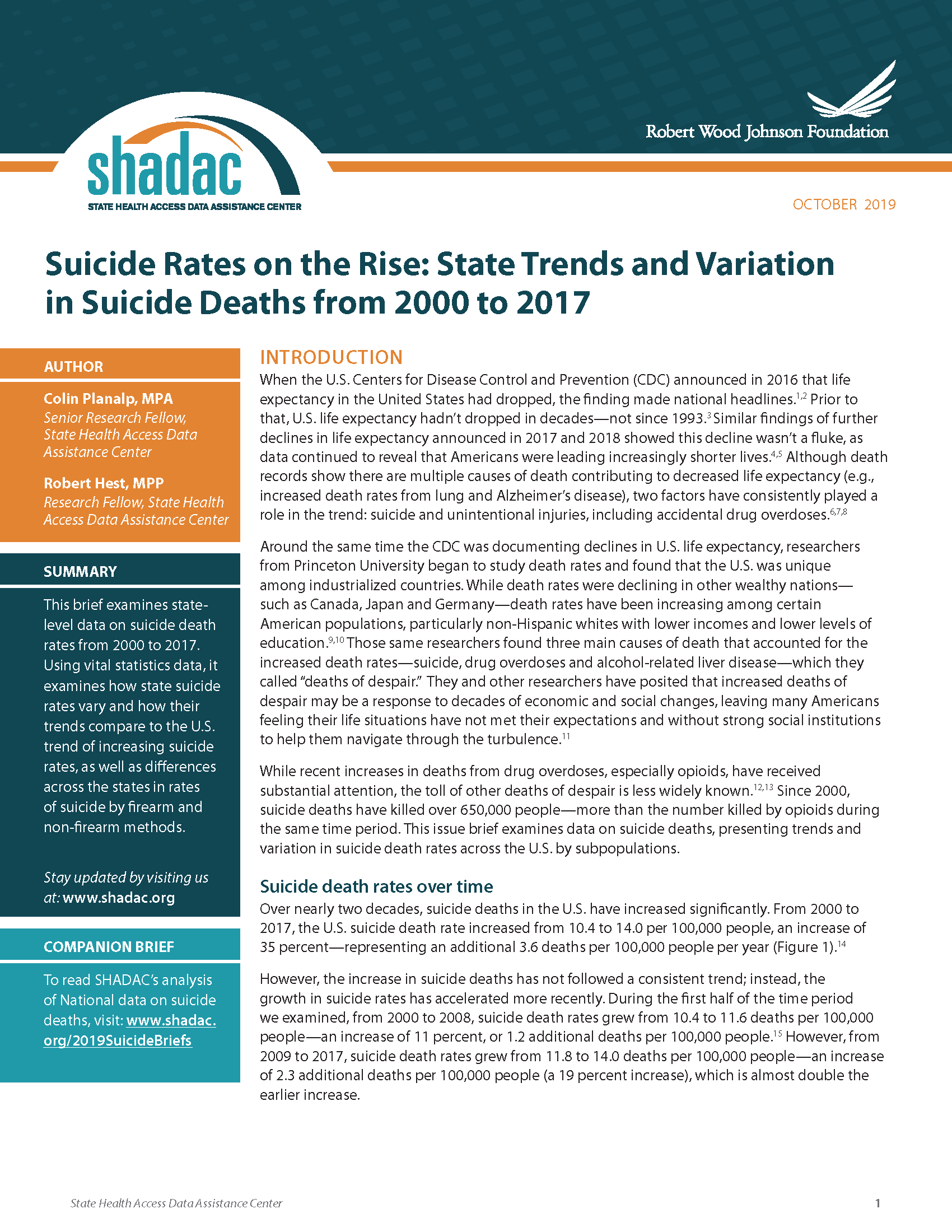Publication
Suicide Rates on the Rise: Trends and Demographics across the Nation and in the States from 2000 to 2017 (Briefs)
Much like the opioid epidemic currently encompassing the nation, death rates from suicide in the United States have been increasing at an alarming pace in recent decades. While the toll of opioids has received substantial attention, the toll from other causes of what researchers have termed “deaths of despair,” such as suicide, is less widely known.[1],[2] Yet the U.S. suicide death rate is on the rise, increasing from 10.4 to 14.0 per 100,000 people from 2000 to 2017 (an increase of 35 percent), and suicide has killed over 650,000 people since 2000—more than the number killed by opioids during the same time period.
However, while suicide deaths have increased significantly over the past nearly two decades, this growth has not followed a consistent trend but rather accelerated in more recent years. This finding is consistent with a recent report released by the Centers for Disease Control and Prevention (CDC) that focused on suicide rates among children and adolescents (age groups 10-14, 15-19, and 20-24) from 2000 to 2017.[3]
As part of a new analysis aiming to shed more light on this growing public health concern, SHADAC researchers have produced two issue briefs that provide high-level information regarding trends in suicide deaths from 2000 to 2017. Each brief presents historical context for the troubling recent acceleration in the rise of suicide rates and mortality in the United States, and examine trends in suicide-related mortality across the nation and states, and among population subgroups. Click on the briefs below to download.
Sources
Data on Suicide Deaths have also been added as a new measure to SHADAC’s State Health Compare tool and can be viewed by demographics including age, gender, race/ethnicity, method, and metropolitan status. Estimates on State Health Compare come from the Centers for Disease Control and Prevention (CDC), National Center for Health Statistics via the CDC WONDER Database.
National Suicide Prevention Lifeline: 1-800-273-8255
If you’re thinking about suicide, are worried about a friend or loved one, or would like emotional support, the Lifeline network is available 24/7 across the United States. For more suicide prevention resources, visit https://suicidepreventionlifeline.org/
[1] State Health Data Access Assistance Center (SHADAC). (2019). The Opioid Epidemic: National Trends in Opioid-Related Overdose Deaths from 2000 to 2017 [PDF file]. Retrieved from https://www.shadac.org/publications/ opioid-epidemic-national-and-state-trends-opioid-related-overdose-deaths-2000-2017
[2] State Health Data Access Assistance Center (SHADAC). (2019). The Opioid Epidemic: State Trends in Opioid-Related Overdose Deaths from 2000 to 2017 [PDF file]. Retrieved from https://www.shadac.org/publications/opioid-epidemic-national-and-state-trends-opioid-related-overdose-deaths-2000-2017
[3] Curtin, S. C., & Heron, M. (2019). Death Rates Due to Suicide and Homicide Among Persons Aged 10-24: United States, 2000-2017 [NCHS Data Brief No. 352]. Retrieved from https://www.cdc.gov/nchs/data/databriefs/db352-h.pdf











